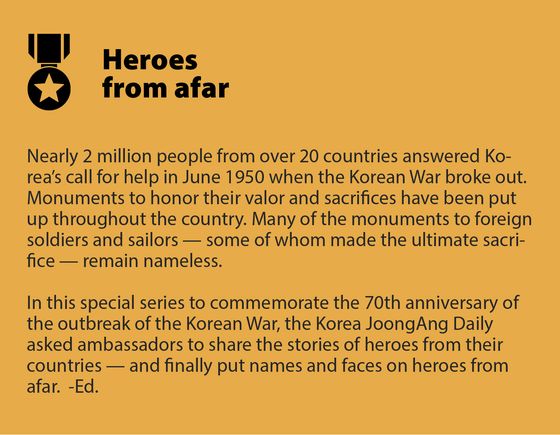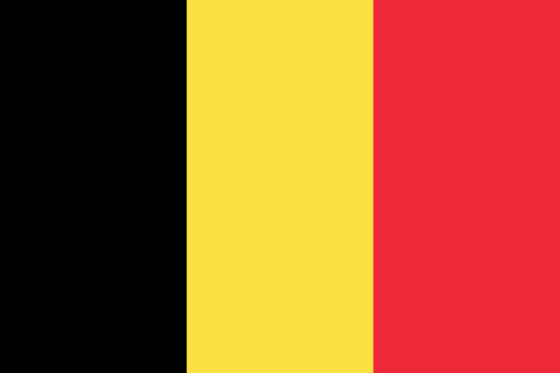[Heroes from afar] Belgians arrived to help the South recapture Seoul
![Ambassador of Belgium to Korea Peter Lescouhier speaks with the Korea JoongAng Daily on Nov. 3. [PARK SANG-MOON]](https://koreajoongangdaily.joins.com/data/photo/2020/11/29/13b72fed-52ff-4206-a85f-bf9e5c5b73b7.jpg)
Ambassador of Belgium to Korea Peter Lescouhier speaks with the Korea JoongAng Daily on Nov. 3. [PARK SANG-MOON]
Thousands signed up to fight, motivated by invasions in world wars

“I take the respectful liberty to write you to ask for your support for my candidacy to join the mission to Korea,” Flore Jeanpierre wrote on Aug. 18, 1950.
“I have paid attention to the events with regard to the war in Korea and I heard that some countries [are providing] medical help. Our small country, always ready to contribute to peace, will certainly not stay behind. I graduated as a nurse and am willing to do my part.”
![Flore Jeanpierre's letter. [EMBASSY OF BELGIUM IN KOREA]](https://koreajoongangdaily.joins.com/data/photo/2020/11/29/aee69314-d903-4a08-acf2-520d6ae7d233.jpg)
Flore Jeanpierre's letter. [EMBASSY OF BELGIUM IN KOREA]
“There was a lot of sympathy in Belgium at the time with what happened in the Republic of Korea, as Belgium had been invaded twice, unprovoked, in the two world wars,” Belgian Ambassador to Korea Peter Lescouhier said during an interview at the embassy on Nov. 3. “Our ministry at the time received letters from people who said they wanted to volunteer, even before the government officially had decided to send troops.”
It was on Aug. 25, 1950, that the Belgian government created a battalion with 700 soldiers of the roughly 2,000 who volunteered, according to the records at Korea’s Ministry of Patriots and Veterans Affairs. Together with the volunteers from Luxembourg, they formed the Bel-Lux Battalion.
Throughout the war, a total of 3,498 Belgian soldiers served, from Jan. 31, 1951, through June 15, 1955. A total of 89 soldiers from Luxembourg served with the Belgians, according to the Belgian Embassy in Seoul.
![Members of the Belgian forces in Korea during the war. [EMBASSY OF BELGIUM IN KOREA]](https://koreajoongangdaily.joins.com/data/photo/2020/11/29/804f6ff7-5814-41de-9599-acea888d1d20.jpg)
Members of the Belgian forces in Korea during the war. [EMBASSY OF BELGIUM IN KOREA]
“Minister Melen stepped down [from his office] to be able to join the troops in Korea,” said Lescouhier. “He firmly believed that Belgium had to be there, so he was very consequent in his deeds.”
![Belgium's Minister of Defense Henri Moreau de Melen serving in the Korean War. [EMBASSY OF BELGIUM IN KOREA]](https://koreajoongangdaily.joins.com/data/photo/2020/11/29/974df310-f800-403d-b379-921de6bd039b.jpg)
Belgium's Minister of Defense Henri Moreau de Melen serving in the Korean War. [EMBASSY OF BELGIUM IN KOREA]
“I had just finished school, a military school, and I served two years to become sergeant,” First Sergeant Major Gaston Francson wrote in an account cited in “Operatie in Korea,” by Petra Gunst. “Did I deserve that grade? The only way to know was to put myself to the test. I cannot deny it, I was also tempted by the adventure. We were 20, 21 or 22 years old. At that age you dream of traveling and seeing the world. I didn’t even know where Korea was. I thought it had to be in Asia, but I was unable to point it on a map. For all these reasons I volunteered and found myself in Korea in 1951.”
Commander Albert Crahay, the first commander of the Bel-Lux Battalion, recalled traveling six weeks on Kamina and the angst they all felt onboard.
“The French and Dutch troops were already in Korea, and we were still in Europe. We feared that we would arrive too late,” Commander Crahay is cited to have said in “Operatie in Korea.” “MacArthur had already started a glorious counter-offensive, supported by a landing in Incheon. The North Koreans were put to flight, and at several places the Chinese border was reached. Would we arrive when everything was already finished?”
But the war was far from over. With the Chinese offensives beginning in late October of 1950, the United Nations forces had been pushed south, and the Chinese and North Koreans had recaptured Seoul by Jan. 4, 1951.
After completing their training in Busan through early February, the battalion was assigned to anti-guerilla patrol duty in Waegwan-eup, north of Daegu, on Feb. 9, 1951, and subsequently assigned to the 3rd U.S. Infantry Division and placed in defensive positions for Operation Ripper in March in Suwon, Gyeonggi.
The battalion experienced their first casualties when Lt. Pierre Beauprez, at the time leading a patrol with American soldiers on the southern bank of the Han River, was killed by a Chinese land mine. The explosion also wounded Lt. Benoit Verhaegan and other American soldiers.
![A Korean soldier with Belgian soldiers during the war. [KOREA MILITARY ACADEMY]](https://koreajoongangdaily.joins.com/data/photo/2020/11/29/4477156d-58b4-4fd3-91b8-8c7729f564c9.jpg)
A Korean soldier with Belgian soldiers during the war. [KOREA MILITARY ACADEMY]
“The Belgian battalion with the Luxembourg detachment of the UN Forces in Korea is mentioned for exceptional execution of its missions and for its remarkable heroism in its actions against the enemy on the Imjin, near Hantangang, Korea during the period from 20 till 26 April 1951,” reads the citation from the United States. “The Belgian battalion with the Luxembourg detachment, one of the smallest units of the [UN Command] in Korea, has inflicted thirty-fold losses on the enemy compared to its own, due to its aggressive and courageous actions against the Communist Chinese.”
The Belgians were assigned to defend the south bank of the Han River in Operation Ripper and moved south of the Imjin River in Operation Courageous in March 1951.
They fought during the Chinese spring offensives in April that year during the Battle of Mount Geumgul near the inter-Korean border. Their mission was to defend the position until the UN forces on their right had successfully retreated, which they accomplished.
In his encounters with the Belgian veterans of the war, Lescouhier said he heard the most about the brutalities of the battles of Imjin, Hakdang-ri and Jatgol.
“The most severe battle took place a few months before the armistice in 1953,” said Lescouhier. “During the Battle of Jatgol they were under very heavy attacks from the Chinese troops, especially in the night form April 17 to 18, they had over 2,000 mortar attacks and there were many artillery attacks the whole month through, during 55 days [they say] it was really the hell of Jatgol.”
During their engagement with the enemy from April 18 to 19 in 1953, the Bel-Lux Battalion came under fire by an estimated 3,100 rounds of artillery and mortar shells, while they fired some 36,000 rounds of light machine gun fire, 7,000 rounds of heavy machine gun fire and 6,000 rounds of Browning Automatic Rifle fire, according to records at Korea’s Ministry of Patriots and Veterans Affairs.
The brother of Etienne Gailly, the marathoner, who had also served in the war, was among those killed during the battle. Capt. Pierre Gailly’s plane was shot down by enemy fire on March 30, 1953. Etienne Gailly set out to search for him but was unsuccessful. The runner also sustained an injury during the war, which ended his athletic career.
By the end of the war, 101 Belgians and two Luxembourgers had been killed. Another 350 members of the Bel-Lux Battalion were injured and five had gone missing, according to the Belgian Embassy in Seoul.
![Korean War memorial in Brussels, Belgium. [KOREA MILITARY ACADEMY]](https://koreajoongangdaily.joins.com/data/photo/2020/11/29/eccb56c1-c36a-48d7-8dee-a26739b517fc.jpg)
Korean War memorial in Brussels, Belgium. [KOREA MILITARY ACADEMY]
Once, during the battle of Jatgol, there was a moment of quiet on the frontlines. Raymond Behr, a Belgian soldier, decided to put the moment to good use by driving with a Catholic priest, who was also part of the battalion, to Seoul in order to meet with a group of Korean orphans.
They had packed some chocolate, jam and other rations from the unit for the children, and Behr, in his written account to the embassy in Seoul in 2018, recalled the visit.
“It was a joy to see the radiant eyes of the little ones as they greedily sampled their chocolate,” he wrote. “Tears came to us!”
Behr was told that the Bel-Lux Battalion had been called back to the front lines, as another battle was ensuing. Speeding back in their vehicle to the battlefront, they were called to halt by an American military police officer.
“Our padre, a gifted orator, gave the MP [military police] in a deluge the explanation that our Battalion was rushing to go to the front line and we had been ordered to join them directly,” Behr wrote to the embassy.
![Belgian veterans including Raymond Behr, far left, in a ceremony to honor the veterans of the Korean War. [KOREA MILITARY ACADEMY]](https://koreajoongangdaily.joins.com/data/photo/2020/11/29/5d9a9d7e-8123-48af-a84f-a5ebf6c44a8d.jpg)
Belgian veterans including Raymond Behr, far left, in a ceremony to honor the veterans of the Korean War. [KOREA MILITARY ACADEMY]
“He answered with all his composure in a Texan accent, ‘Well, are you perhaps some of those who volunteered came to this war?’ To which our padre answered him, ‘Yes, we are of those men who came to Korea to help those helpless people!’ [To] which the MP said, ‘Well, well, then drive very quickly to hell!’ And we drove, as Americans say, ‘Like hell!’”
The ambassador also said the Belgian soldiers had a nickname among the Korean people — “byeoruk,” the Hangul word for fleas.
“The Belgians I heard were very generous with their rations and so the children must have been not afraid of them, which is probably why they could call them fleas,” said Lescouhier.
The Belgians and Luxembourgers departed in stages following the signing of the armistice in July 1953, with some 200 Belgian troops remaining through June 1955 for peacekeeping purposes.
But the legends of the brown berets have lived on.
“When the Belgians came back from the war, the flag of the Belgian United Nations Command was adopted by the Paracommando of Belgium and this was also where the king received his paracommando training,” Lescouhier said. “Which means he is wearing the same beret as the Korean War volunteers.”
![Belgian King Philippe and Queen Mathilde at the War Memorial of Korea during their state visit in March 2019. [WAR MEMORIAL OF KOREA]](https://koreajoongangdaily.joins.com/data/photo/2020/11/29/27d62244-4c33-4c4e-848c-3290405adad0.jpg)
Belgian King Philippe and Queen Mathilde at the War Memorial of Korea during their state visit in March 2019. [WAR MEMORIAL OF KOREA]
BY ESTHER CHUNG [chung.juhee@joongang.co.kr]

Belgium committed 3,498 soldiers to the Korean War, from Jan. 31, 1951, to June 15, 1955. A total of 89 soldiers from Luxembourg served with the Belgians, forming the Bel-Lux Battalion.
By the end of the war, a total of 101 Belgians and two Luxembourgers had been killed. Another 350 of the Bel-Lux Battalion were injured and five had gone missing, according to the Belgian Embassy in Seoul.
To this day, the Paracommando of Belgium carry the same flag that the Belgian United Nations Command forces carried.
This series is a weekly publication in cooperation with the 70th Anniversary of the Korean War Commemoration Committee.











with the Korea JoongAng Daily
To write comments, please log in to one of the accounts.
Standards Board Policy (0/250자)